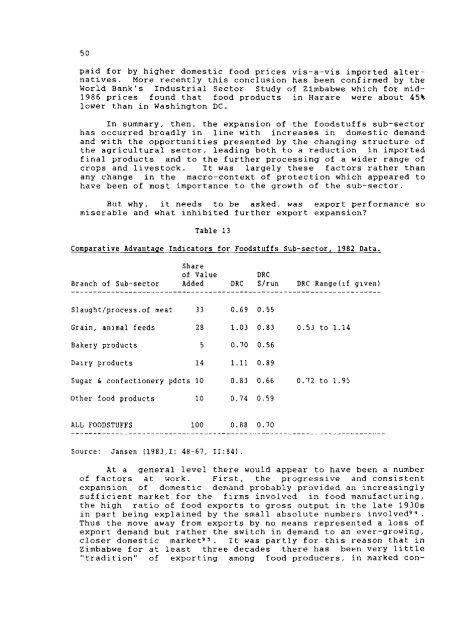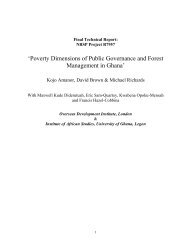Zimbabwe - Overseas Development Institute
Zimbabwe - Overseas Development Institute
Zimbabwe - Overseas Development Institute
You also want an ePaper? Increase the reach of your titles
YUMPU automatically turns print PDFs into web optimized ePapers that Google loves.
paid for by higher domestic food p r i c e s v i s - a - v i s imported a l t e r <br />
n a t i v e s . More r e c e n t l y t h i s conclusion has been confirmed by the<br />
World Bank's I n d u s t r i a l Sector Study of <strong>Zimbabwe</strong> which for mid-<br />
1986 p r i c e s found that food products i n Harare were about 45%<br />
lower than i n Washington DC.<br />
In summary, then, the expansion of the f o o d s t u f f s sub-sector<br />
has occurred broadly i n l i n e with increases i n domestic demand<br />
and with the o p p o r t u n i t i e s presented by the changing s t r u c t u r e of<br />
the a g r i c u l t u r a l sector, leading both to a reduction i n imported<br />
f i n a l products and to the f u r t h e r processing of a wider range of<br />
crops and l i v e s t o c k . I t was l a r g e l y these f a c t o r s rather than<br />
any change i n the macro-context of p r o t e c t i o n which appeared to<br />
have been of most importance to the growth of the sub-sector.<br />
But why, i t needs to be asked, was export performance so<br />
miserable and what i n h i b i t e d f u r t h e r export expansion?<br />
Table 13<br />
Comparative Advantage Indicators for Foodstuffs Sub-sector, 1982 Data.<br />
Share<br />
of Value DRC<br />
Branch of Sub-sector Added DRC S/run DRC Range (if given)<br />
Slaught/process.of meat 33 0.69 0. .55<br />
Grain, animal feeds 2B 1.03 0, ,83 0.53 to 1.14<br />
Bakery products 5 0.70 0, .56<br />
Dairy products 14 1.11 0, ,89<br />
Sugar i confectionery pdcts 10 0.83 0. ,66 0.72 to 1.95<br />
Other food products 10 0.74 0. 59<br />
ALL FOODSTUFFS 100 0.88 0. ,70<br />
Source: Jansen (1983,1: 48-67, 11:34).<br />
At a general l e v e l there would appear to have been a number<br />
of f a c t o r s at work. F i r s t , the progressive and consistent<br />
expansion of domestic demand probably provided an i n c r e a s i n g l y<br />
s u f f i c i e n t market for the firms involved i n food manufacturing,<br />
the high r a t i o of food exports to gross output i n the l a t e 1930s<br />
i n part being explained by the small absolute numbers involved'".<br />
Thus the move away from exports by no means represented a loss of<br />
export demand but rather the switch i n demand to an ever-growing,<br />
c l o s e r domestic market". I t was p a r t l y f o r t h i s reason that i n<br />
<strong>Zimbabwe</strong> f o r at l e a s t three decades there has been very l i t t l e<br />
" t r a d i t i o n " of exporting among food producers, i n marked con-
















